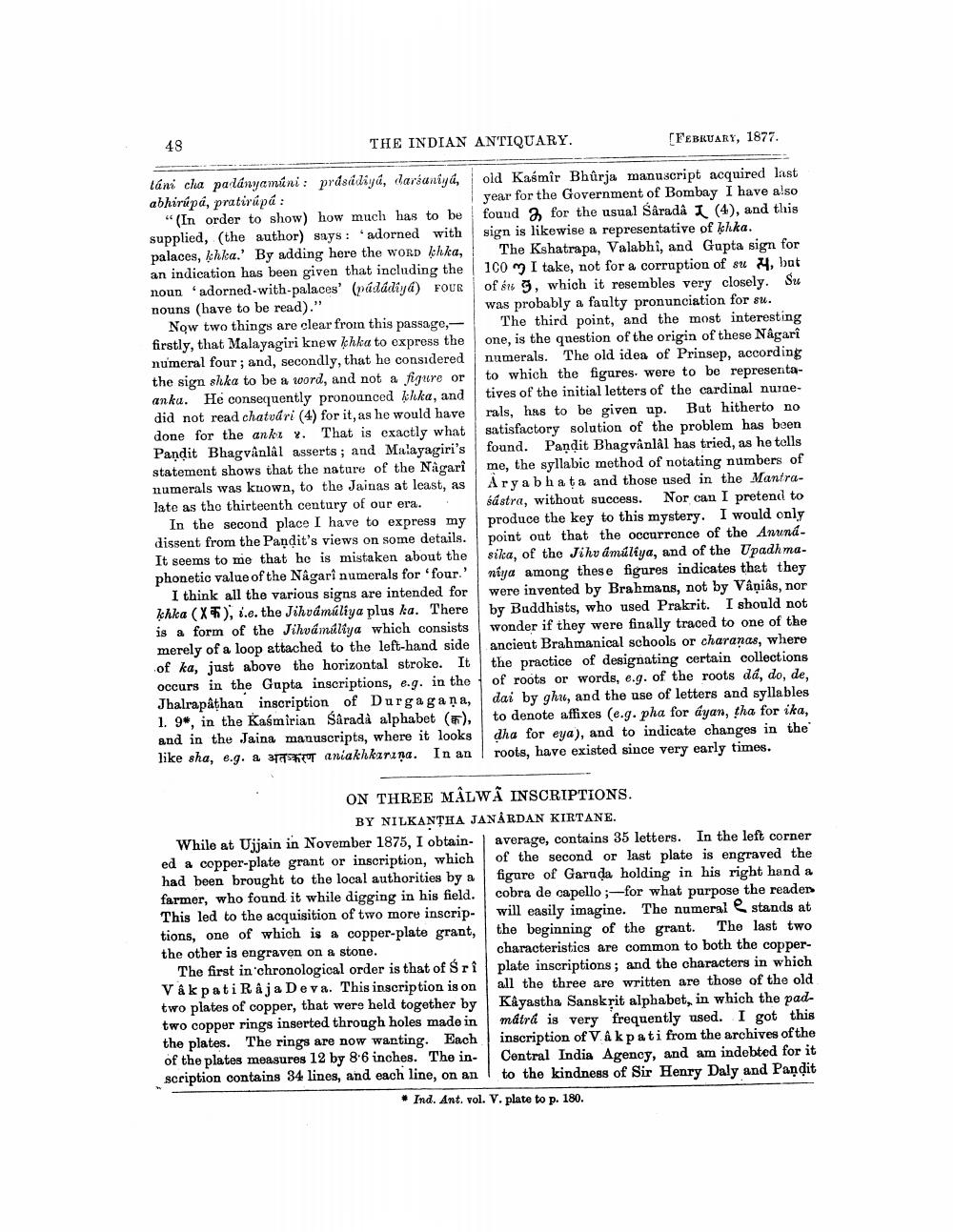________________
48
THE INDIAN ANTIQUARY.
[FEBRUARY, 1877.
táni cha padányamini: prisidiya, larsaniyd, old Kasmir Bhûrja manuscript acquired last abhirúpa, pratirúpá:
year for the Government of Bombay I have also "(In order to show) how much has to be found 2 for the usual Sarada I (4), and this supplied, the author) says: "adorned with sign is likewise a representative of Ichka. palaces, khka.' By adding here the word chka, 1 The Kshatrapa, Valabhi, and Gupta sign for an indication has been given that including the 100 m I take, not for a corruption of su 7, but noun adorned-with-palaces' (pádádiya) FOUR of ég, which it resembles very closely. Su nouns (have to be read)."
was probably a faulty pronunciation for su. Now two things are clear from this passage, - The third point, and the most interesting firstly, that Malayagiri knew chka to express the one, is the question of the origin of these Nagari numeral four; and, secondly, that he considered numerals. The old idea of Prinsep, according the sign shka to be a word, and not a figure or to which the figures were to be representaanku. He consequently pronounced khka, and tives of the initial letters of the cardinal nursedid not read chatvari (4) for it, as he would have rals, has to be given up. But hitherto no done for the ankı y. That is exactly what satisfactory solution of the problem has been Pandit Bhagvanlal asserts; and Malayagiri's found. Pandit Bhagvânlal has tried, as he tells statement shows that the nature of the Nagari me, the syllabic method of notating numbers of numerals was known, to the Jainas at least, as Arya bh a ta and those used in the Mantralate as the thirteenth century of our era. . sástra, without success. Nor can I pretend to
In the second place I have to express my produce the key to this mystery. I would only dissent from the Pandit's views on some details. point out that the occurrence of the Anuná. It seems to me that he is mistaken about the silca, of the Jihv amíliya, and of the Upadh maphonetic value of the Nagari numerals for 'four.' niya among these figures indicates that they
I think all the various signs are intended for were invented by Brahmans, not by Vâņiâs, nor ķhka (X), 1.e. the Jihvámáliya plus ka. There by Buddhists, who used Prakrit. I shonld not is a form of the Jihvá múliya which consists wonder if they were finally traced to one of the merely of a loop attached to the left-hand side ancient Brahmanical schools or charanas, where of ka, just above the horizontal stroke. It the practice of designating certain collections occurs in the Gupta inscriptions, e.g. in the of roots or words, e.g. of the roots dá, do, de, Jhalrapâthan inscription of Durgagana, dai by ghre, and the use of letters and syllables 1. 9*, in the Kasmirian sâradà alphabet (), to denote affixes (e.g. pha for ayan, tha for ika, and in the Jaina manuscripts, where it looks dha for eya), and to indicate changes in the like sha, e.g. a 3 aniakhkanıņa. In an | roots, have existed since very early times.
ON THREE MÂLWA INSCRIPTIONS.
BY NILKANTHA JANÅRDAN KIRTANE. While at Ujjain in November 1875, I obtain average, contains 35 letters. In the left corner ed & copper-plate grant or inscription, which of the second or last plate is engraved the had been brought to the local authorities by a figure of Garuda holding in his right hand a farmer, who found it while digging in his field. cobra de capello ;for what purpose the reader This led to the acquisition of two more inscrip- will easily imagine. The numeral stands at tions, one of which is a copper-plate grant, the beginning of the grant. The last two the other is engraven on a stone.
characteristics are common to both the copperThe first in chronological order is that of Sri plate inscriptions; and the characters in which Vák pati Raja Deva. This inscription is on all the three are written are those of the old two plates of copper, that were held together by Kayastha Sanskrit alphabet, in which the padtwo copper rings inserted through holes made in mátrá is very frequently used. I got this the plates. The rings are now wanting. Each inscription of Vâk pati from the archives of the of the plates measures 12 by 86 inches. The in- Contral India Agency, and am indebted for it scription contains 34 lines, and each line, on an to the kindness of Sir Henry Daly and Pandit
• Ind. Ant. vol. V. plate to p. 180.




